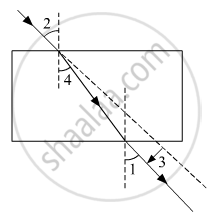Advertisements
Advertisements
प्रश्न
The atmospheric refraction of light causes the twinkling of:
(a) planets only
(b) stars only
(c) planets and stars
(d) stars and satellites
उत्तर
stars only
The twinkling of stars is caused by the atmospheric refraction of light.
APPEARS IN
संबंधित प्रश्न
The correct sequencing of angle of incidence, angle of emergence, angle of refraction and lateral displacement shown in the following diagram by digits 1, 2, 3 and 4 is:

(a) 2, 4, 1, 3
(b) 2, 1, 4, 3
(c) 1, 2, 4, 3
(d) 2, 1, 3, 4
State whether the following statement is true or false:
The planets twinkle at night due to atmospheric refraction of light.
Why do stars seem higher than they actually are? Illustrate your answer with the help of a diagram.
The twinkling of stars is due to atmospheric:
(a) reflection of light
(b) dispersion of light
(c) interference of light
(d) refraction of light
As light from a far off star comes down towards the earth:
(a) it bends away from the normal
(b) it bends towards the normal
(c) it does not bend at all
(d) it is reflected back
A student claims that because of atmospheric refraction, the sun can be seen after it has set, and the day is, therefore, longer than if the earth had no atmosphere.
Do you think that the students conclusion is correct?
Which of the following is not caused by the atmospheric refraction of light?
(a) twinkling of stars at night
(b) sun appearing higher in the sky than it actually is
(c) sun becoming visible two minutes before actual sunrise
(d) sun appearing red at sunset
The air layer of the atmosphere whose temperature is less than the hot layer behave as optically:
Assertion: Sky appears blue in the day time.
Reason: White light is composed of seven colours.
Explain the refraction of light through a triangular glass prism using a labelled ray diagram. Hence define the angle of deviation.
